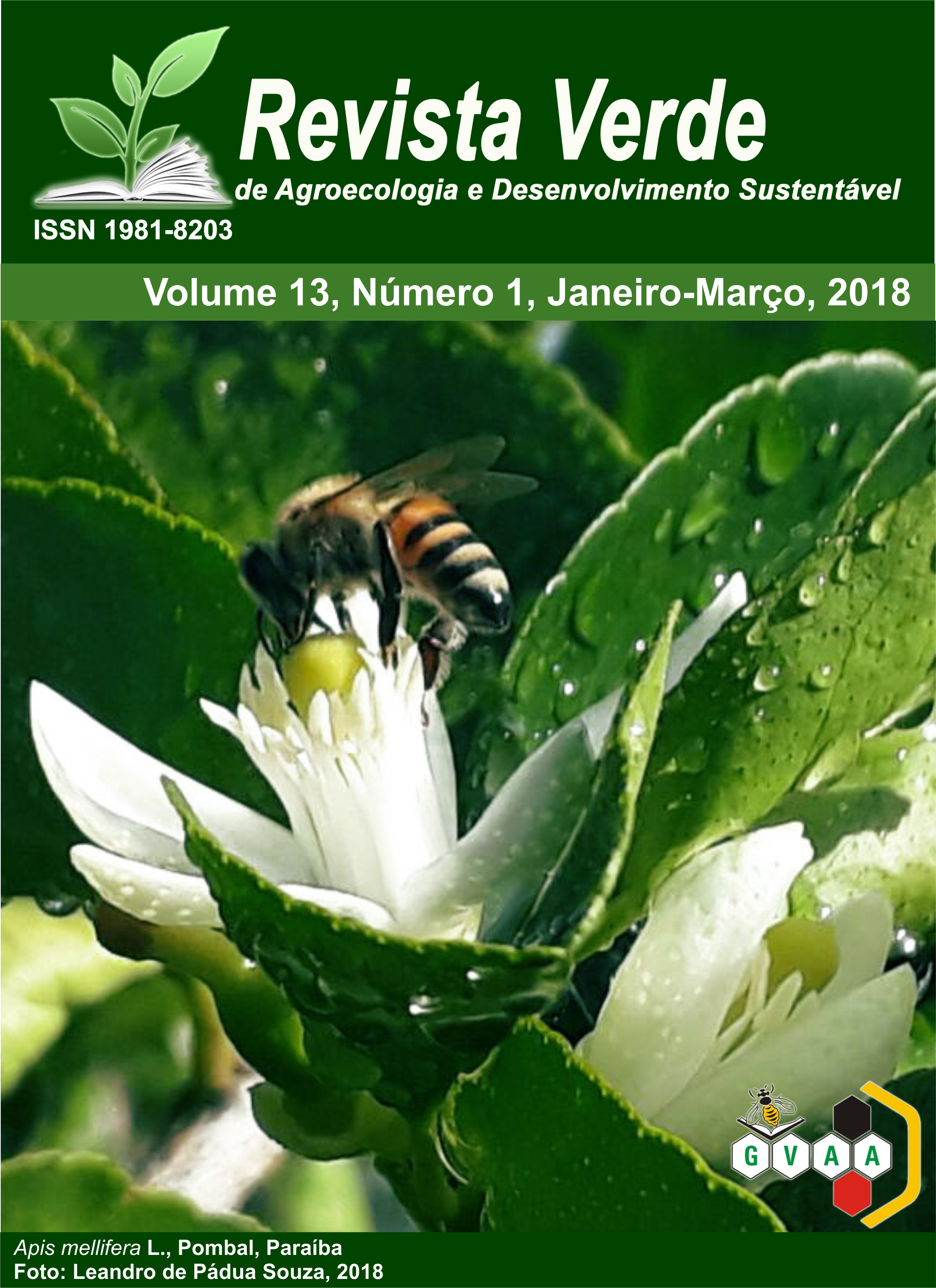The ability of rhizobacteria to solubilize phosphate and synthesize of indoleacetic acid in cowpea
DOI:
https://doi.org/10.18378/rvads.v13i1.5275Keywords:
Indole acetic acid, Bradyrhizobium, Vigna unguiculata L. Walp., Biomass, Plant growth.Abstract
The Cerrado comprises a vast ecoregion in central Brazil where plants show both growth and nitrogen fixation deficiencies due to low soil fertility. Farmers may overcome such problem using species of microorganisms capable of improving soil fertility such as the Rhizobia bacteria. This work aimed to assess the ability of phosphate solubilization and synthesis of indoleacetic acid (IAA) of Rhizobium isolates obtained from Cerrado soils in the state of Tocantins, Brazil, evaluating their symbiotic efficiency in cowpea (Vigna unguiculata L. Walp.) plants. We used a total of 32 isolates (or strains) of Rhizobium and a reference species of Bradyrhizobium. The capacity of phosphate solubilization and synthesis of IAA was evaluated in vitro, while the symbiotic function of rhizobia isolates and the effect on cowpea biomass was assessed in a greenhouse. Only eight strains were able to solubilize calcium phosphate, while all isolates produced IAA. The rhizobia inoculation caused a significant increase in biomass and nodulation of cowpea. The isolates UFT R122 and UFT R124 stood out with the highest values for the studied parameters, showing rises above 33% of relative efficiency in comparison to the treatment with nitrogen fertilization. By associating the results of phosphate solubilization capacity, IAA synthesis, symbiotic ability, and nodulation, we conclude that the isolates that showed good performance are potential inoculants for cowpea in Cerrado soils.Downloads
References
BANO, N.; MUSSARAT, J. Isolation and characterization of phorate degrading bacteria of agricultural significance. Letters in Applied Microbiology, v.36, n.6, p.324-328, 2003.
BASTOS, V. J.; MELO, D. A.; ALVES, J. M. A.; UCHÔA, S. C. P.; SILVA, P. M. C.; TEIXEIRA JUNIOR, D. L. Avaliação da fixação biológica de nitrogênio em feijão-caupi submetido a diferentes manejos da vegetação natural na savana de Roraima. Revista Agro@mbiente, v.6, n.2, p.133-139, 2012.
CHAGAS JÚNIOR, A. F.; OLIVEIRA, L. A.; OLIVEIRA, N. A. Produção de ácido indolacético por rizóbios isolados de caupi. Revista Ceres, Viçosa, v. 56, n.6, p.812-817, 2009.
CHAGAS JÚNIOR, A. F.; OLIVEIRA, L. A.; OLIVEIRA, A. N.; WILLERDING, A. L. Capacidade de solubilização de fosfatos e eficiência simbiótica de rizóbios isolados de solos da Amazônia. Acta Scientiarum. Agronomy, Maringá, v.32, n.2, p.359-366, 2010a.
CHAGAS JUNIOR, A. F.; RAHMEIER, R.; FIDELIS, R. R.; SANTOS, G. R.; CHAGAS, L. F. B. Eficiência agronômica de estirpes de rizóbio inoculadas em feijão-caupi no Cerrado, Gurupi- TO. Revista Ciência Agronômica, v.41, p.709-714, 2010b.
DOBBELAERE, S.; VANDERLEYDEN, J.; OKON, Y. Plant growth-promoting effects of diazotrophs in the rhizosphere. Critical Reviews in Plant Sciences, v.22, p.107-149, 2003.
DOROZHKIN, S. A review on the dissolution models of calcium apatites. Progress in Crystal Growth and Characterization of Materials, v.44, p.45–61, 2002.
EMBRAPA. Manual de análises químicas de solos, plantas e fertilizantes. 2nd ed. Embrapa; 2009. 627p.
FREIRE FILHO, F. R. Feijão-caupi no Brasil: produção, melhoramento genético, avanços e desafios. Embrapa Meio-Norte;. Teresina, 2011. 84p.
GORDON, S. A.; WEBER, R. P. Colorimetric estimation of indoleacetic acid. Plant Physiology, v.26, n.1, p.192-195, 1951.
HAMEED, S.; YASMIN, S.; MALIK, K. A.; ZAFAR, Y.; HAFEEZ, F. Y. Rhizobium, Bradyrhizobium and Agrobacterium strain isolated from cultivated legumes. Biology and Fertility of Soils, v.39, n.3, p.179-185, 2004.
HUNGRIA, M.; CAMPO, R. J. Inoculantes microbianos: situação no Brasil. In: Izaguirre Mayoral, M. L.; Labandera, C.; Sanjuan, J. (eds). Biofertilizantes en Iberoamérica: Visión Técnica, Científica y Empresarial. Montevideo, Biofag, 2007. p.22-31.
KRASOVA-WADE, T.; DIOUF, O.; NDOYE, I.; SALL, C. E.; BRACONNIER, S.; NEYRA, M. Water-condition effects on rhizobia competition for cowpea nodule occupancy. African Journal of Biotechnology, v.5, p.1457-1463, 2006.
KUSS, A. V.; KUSS, V. V.; LOVATO, T.; FLÔRES, M. L. Fixação de nitrogênio e produção de ácido indolacético in vitro por bactérias diazotróficas endofíticas. Pesquisa Agropecuária Brasileira, Brasília, v.42, n.10, p.1459-1465, 2007.
SILVA, F. A. S. ASSISTAT. Version 7.6 beta. 2008. Available in: <http://www.assistat.com/indexp.html>.Access in: 10 Mar. 2017.
SILVA FILHO, G. N.; VIDOR, C. Atividade de microrganismos solubilizadores. Pesquisa Agropecuária Brasileira, Brasília, v.36, n.12, p.1495-1508, 2001.
SOARES, A. L. L.; PEREIRA, J. P. A. R.; FERREIRA, P. A. A.; DO VALE, H. M. M.; LIMA, A. S.; ANDRADE, M. J. B.; MOREIRA, F. M. S. Eficiência agronômica de rizóbios selecionados e diversidade de populações nativas nodulíferas em Perdões (MG). I – Caupi. Revista Brasileira de Ciência do Solo, v.30, n.5, p795-802, 2006.
ZILLI, J. E.; VALICHESKI, R. R.; RUMJANEK, N. G.; SIMÕES-ARAÚJO, J. L.; FREIRE FILHO, F. R.; NEVES, M. C. P. Eficiência simbiótica de estirpes de Bradyrhizobium isolados de solo do Cerrado em caupi. Pesquisa Agropecuária Brasileira, Brasília, v.41, n.5, p.811-818, 2006.
ZILLI, J. E.; XAVIER, G. R.; MOREIRA, F. M. S.; FREITAS, A. C. R.; OLIVEIRA, L. A. Fixação biológica de nitrogênio. In: Zilli, J. E et al. (eds). A cultura do feijão-caupi na Amazônia Brasileira. Boa Vista, Embrapa Roraima, 2009a. p.185-221.
ZILLI, J. E.; MARSON, L. C.; MARSON, B. F.; RUMJANEK, N. G.; XAVIER, G. R. Contribuição de estirpes de rizóbio para o desenvolvimento e produtividade de grãos de feijão-caupi em Roraima. Acta Amazônica, Manaus, v.39, p.749-758, 2009b.











